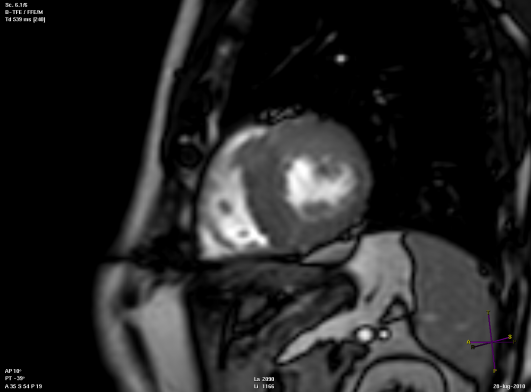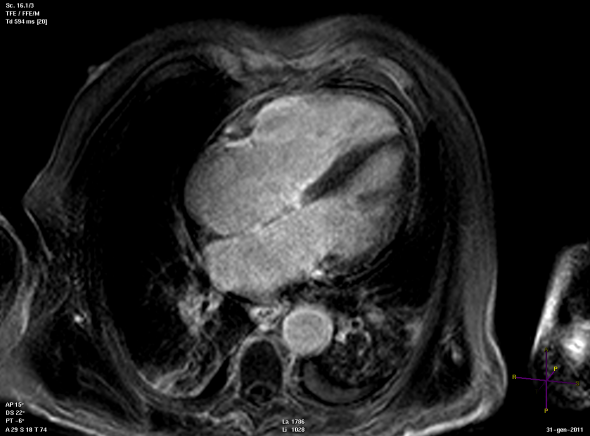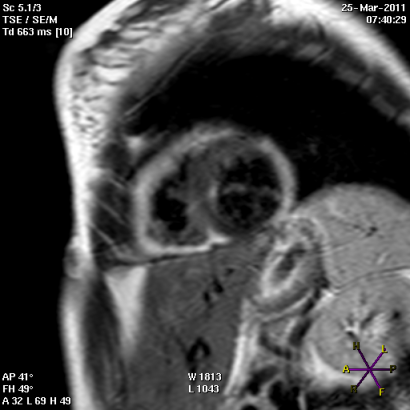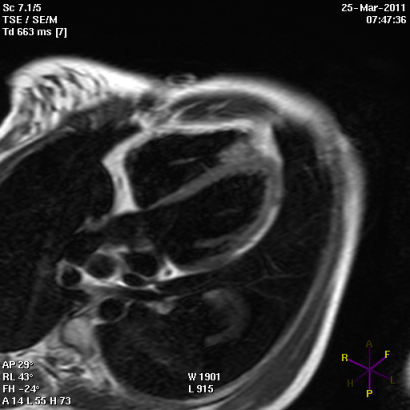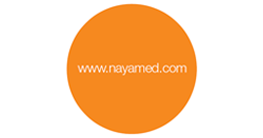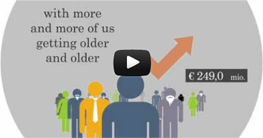Lights and shadows of implantable cardioverter defibrillators implantations in hypertrophic, dilated and arrhythmogenic right ventricular cardiomyopathies.
Posted: April 29, 2013 Filed under: Medical Devices, Opinions | Tags: bradycardia, defibrillator, eHealthcare, Health 2.0, ICD, implantable cardioverter defibrillators, lights, Medical Devices, pacemaker, SCD, sudden cardiac death Leave a commentIn the past decades, implantable cardioverter defibrillators (ICDs) have definitively proved to be superior to antiarrhythmic drugs for the prevention of arrhythmic sudden cardiac death (SCD). Several studies have proved this hypothesis both for primary or secondary (i.e. after a sustained ventricular tachycardia with hemodynamic compromise or ventricular fibrillation) prevention of SCD. However, some complications often occur with ICD implantation, which may be particularly serious for young individuals.
Indications for ICD implantation in young people are mostly ion channel diseases and cardiomyopathies. The latter are structural abnormalities of the myocardium, related to genetic abnormalities, predisposing to malignant ventricular arrhythmias and requiring ICD for the prevention of SCD in some cases.
Hypertrophic cardiomyopathy
Hypertrophic cardiomyopathy (HCM) is one of the most common cardiomyopathies and occurs in the 0.2% of the general population1. It is characterized by localized asymmetrical hypertrophy of the heart and disarray of myocardial cells and filaments. This leads to impaired transmission of electrophysiologic impulses, with an unstable electrical substrate, potentially causing lethal ventricular tachyarrhythmias and SCD.
Short axis view of a cardiac magnetic resonance imaging of a patient affected by hypertrophic cardiomyopathy involving the interventricular septum and the anterior wall of the left ventricle.
ICD implantation in HCM: lights
A minority of patients with HCM are judged to be at increased risk for SCD, whose rate is estimated to be about 1% per year 2. However, malignant ventricular arrhythmias remains the most frequent cause of death in this population.
Beta-blockers have failed to demonstrate significant protection from SCD in HCM patients. Type I and III anti-arrhythmic drugs, including amiodarone, have been abandoned because of inefficacy and pro-arrhythmic side effects. Experiences with endocardial and epicardial mapping and ablation in HCM are poor and limited to highly selected patients.
ICDs, conversely, have been proved effective in terminating life-threatening ventricular tachyarrhythmias in HCM and are currently considered the only available tools altering the natural course of the disease and prolonging life.
Appropriate intervention rates of ICD in HCM have been esteemed to be about 11% and 4% for secondary and primary prevention respectively3.
Current recommendation for ICD in HCM
HCM has heterogeneous clinical manifestations in different individuals and a not well predictable clinical course. Targeting HCM-patients for prophylactic ICD implantation can therefore be challenging. However, some “risk factors” have been individuated, that commonly guide the decision for ICD implantation. Current international guidelines recommend ICD in all cases of secondary prevention or when familiar history of SCD, marked left ventricular (LV) hypertrophy or recent unexplained syncopal episodes are present. The role of ICD is uncertain for non-sustained VT or an abnormal blood pressure response with exercise.
ICD implantation in HCM: shadows
Previous studies have reported up to 5.1%/year rate of ICD-related complications in HCM4.
The most frequently reported is inappropriate shock delivery, mostly due to erroneous detection and treatment of atrial fibrillation by the ICD. A retrospective study on 334 consecutive HCM patients with an ICD, showed a rate of appropriate vs. inappropriate shock delivery of 2.3 and 4.6%/year5. Moreover, a recent meta-analysis involving 2190 ICD-recipients affected by HCM, showed a rate of appropriate vs. inappropriate ICD interventions of 3.3 vs. 4.8%/year respectively4.
Another extremely rare complication with ICDs in HCM, is represented by loss of capture due to high pacing thresholds (i.e. energy required for effective right ventricular pacing). This is related to ventricular hypertrophy and may be prevented by accurate individuation of the optimal pacing threshold during ICD programming.
Lengthened mitral valve leaflets, and left ventricular outflow tract obstruction due to LV hypertrophy, also confers a relatively higher risk of infection and endocarditis to HCM patients, which must be considered when an ICD implantation is programmed. Moreover, since ICD implantation in HCM is commonly performed at a relatively young age, patients are supposed to necessitate of a number of interventions for pulse generator substitution over their entire life. For this reason, risk of infection and endocarditis (related to ICD substitutions) is amplified. Eventual needing of ICD and intra-cardiac leads extraction over time must be considered. This is a high-risk procedure, possibly complicated by cardiac tamponade, shock, anemia, arrhythmias or even death.
Finally, ICD implantation can be accompanied by depression, anxiety, reduced quality of life, particularly in young people.
Idiopathic dilated cardiomyopathy
Idiopathic dilated cardiomyopathy (IDCM) is a myocardial disease characterized by LV dilation and systolic dysfunction, commonly resulting in heart failure (HF) and for whom an etiological basis cannot be identified. IDCM is relatively rare (36.5% new cases/year/100.000 persons) but accounts for nearly 10.000 deaths/year in the United States, both due to HF and arrhythmic SCD6.
Long axis view of a cardiac magnetic resonance imaging of a patient affected by dilated cardiomyopathy
ICD implantation in IDCM: lights
ICD are effective for the prevention of SCD in IDCM and can favorably alter the natural course of the disease. Previous studies have showed a rate of appropriate interventions of 5 to 7.5%/year in IDCM-patients with an ICD implanted for primary prevention 7-8. A large meta-analysis has showed a reduction of mortality with ICD of about 3.5%/year compared to the best medical therapy in IDCM 9.
Recommendation for ICD in IDCM
The most important risk factor for ventricular arrhythmias in primary prevention of SCD in IDCM, is represented by severe contractile dysfunction, quantified by the measurement of the ejection fraction (EF) at echocardiography. Functional status, assessed by the New York Heart Association (NYHA) class, also plays a role.
Current international guidelines recommend ICD always for secondary prevention. In case of primary prevention, ICD must be implanted in patients with LVEF ≤35% and NYHA class II and III10. However, in a real-life setting, the decision making for patients with IDCM is more complex, because issues such as additional cardiac resynchronization therapy (CRT), co-morbidities, the potential to improve LVEF over time, and eventual genetic etiology also should be considered. With regard to the last issue, carriers of mutations in gene encoding for laminin, are tough to be at increased risk of complete atrio-ventricular block, malignant ventricular arrhythmias and SCD, and may therefore require ICD implantation independently from the EF%.
ICD implantation in IDCM: shadows and warnings
Some shadows obscure the scenario of SCD prevention with ICDs in IDCM.
An important issue regards the high number of patients to be treated in order to save one life because of a currently adopted risk stratification process that appears to lack specificity.
Another topic is the correct timing for ICD implantation for primary prevention. A post hoc analysis of the DEFINITE trials 11 showed that only patients who had received their ICD not later than 3 months after the diagnosis of IDCM would have benefit from implant. However, a significant number of IDCM-individuals show marked improvement of the EF over time, up to values higher than those for which ICD implantation is currently recommended. The goal therefore, appears to be an early and correct individuation of those subjects who will have a negative clinical course, and will therefore require an early ICD implantation for primary prevention.
Similarly to HCM, ICD-related complications have been also reported by various studies, among whom:
- inappropriate shocks, with consequent reduction of quality of life;
- infections;
- risks related to eventual lead extractions;
- depression and anxiety.
Arrhythmogenic right ventricular cardiomyopathy
Arrhythmogenic right ventricular cardiomyopathy (ARVC) is a genetic cardiomyopathy characterized by progressive fibro-fatty replacement of the right ventricular myocardium, sometimes extending also to the left ventricle. The clinical presentation is usually related to ventricular tachycardia (VT) with a left bundle branch block pattern or ventricular fibrillation (VF) leading to SCD. ARVC is a progressive disease ultimately leading to HF.
Panel A
Panel B
Short (Panel A) and long axis views (panel B) of a cardiac magnetic resonance imaging of a patient affected by arrhythmogenic right ventricular cardiomyopathy, with evident fibro-fatty replacement of the right ventricle wall, the apex and partial involvement of the left ventricle wall.
ICD implantation in ARVC: lights
The therapeutic options for ventricular arrhythmias in ARVC include catheter ablation and antiarrhythmic drugs such as beta blockers, sotalol and amiodarone. However, these strategies have proved to improve symptoms but not to increase survival. Nowadays, ICD remains the most effective safe-guard against SCD in ARVC.
In a large multicenter international study enrolling ARVC patients with an ICD implanted for primary prevention, appropriate device interventions were observed in one fourth of patients after 5 years. The annual rate of potentially “life-saving” shocks against VF was 3.3% and the estimated benefit of ICD implantation was of 23% after 2 years 12. Another recent prospective study enrolling a cohort of ARVC patients with an ICD implanted for primary prevention, reported appropriate device interventions in nearly one-half of individuals over a period of 4.7 years 13.
Recommendation for ICD in ARVC
As for IDCM and HCM, ICD implantation is recommended in ARVC for secondary prevention (aborted SCD, VF or hemodynamically unstable sustained VT). ICD is also recommended for primary prevention in patients with LVEF≤35%, severe right ventricular dilation and/or dysfunction, a syncopal episode suggestive for VT or VF or an affected family member with SCD. Other risk factors include: non-sustained VT, early onset of the disease and competitive sport activity.
ICD implantation in ARVC: shadows.
Several studies have proved a relatively high incidence of device-related complications in ARVC patients with an implanted ICD. In a study of 132 patients, five individuals required an additional lead because of pacing failure and one patient died from endocarditis secondary to device infection 14. Progression of fibro-fatty replacement of the myocardial tissue has been associated with high pacing thresholds and impedances and eventual loss of capture. Up to 37% lead-related complication in 7 years have been described in ARVC patients with an implanted ICD 15.
Considerations
The decision regarding ICD implantation is highly significant for any individual at risk of SCD. The clinical decision-making process itself is complex and imply consideration of a number of different aspects. Despite ICD is the only life-prolonging therapy in cardiomyopathies, eventually associated complications should be considered.
Modern technology, such as that utilized by NayaMed, has currently developed sophisticated algorithms allowing an accurate discrimination of supraventricular from ventricular arrhythmic episodes and properly guiding ICD therapies. A growing knowledge of those algorithms by the cardiologists would hopefully reduce the rate of inappropriately delivered shocks by ICDs.
Reliable RV lead alerts and RV lead integrity algorithms, also a constant automatic measurement of leads’ impedances and P, R Waves amplitude have also been implemented in the ICDs of NayaMed, preventing the problems caused by a lead failure. However, despite such algorithms, a complete abolition of ICD-related complications in cardiomyopathies is unreliable. Therefore, an accurate risk stratification appears necessary, as well as a careful weigh of the relative risks and benefits of ICD implantation in each individual.
Dr. Annamaria Martino
Dr. Leonardo Calo
Policlinico Casilino
Roma, Italy
References
1) Gersh J, Maron BJ, Bonow RO et al. 2011 ACCF/AHA Guideline for the Diagnosis and Treatment of Hypertrophic Cardiomyopathy: A Report of the American College of Cardiology Foundation/ American Heart Association Task Force on Practice Guidelines. J Am Coll Cardiol 2011; 58:e212-260
2) Maron BJ. Hypertrophic cardiomyopathy: a systematic review. JAMA 2002; 287:1308-1320
3) Maron BJ, Spirito B, Shen WK et al. Implantable cardioverter defibrillators and prevention of sudden cardiac death in hypertrophyc cardiomyopathy. JAMA 2007; 298: 405-412
4) O’Mahony C, Lambiase PD, Quarta G et al. The long-term survival and the risk and benefits of implantable cardioverter defibrillators in patients with hypertrophic cardiomyopathy. Heart 2012;98:116-125
5) Schinkel AF, Vriesendorp PA, Sijbrands EJ et al. Outcome and complications after implantable cardioverter defibrillator therapy in hypertrophic cardiomyopathy: systematic review and meta-analysis. Circ Heart Fail 2012;5:552-559
6) Codd MB, Sugrue DD, Gersh BJ et al. Epidemiology of idiopathic dilated and hypertrophic cardiomyopathy. A population based study in Olmsted County, Minnesota, 1975–1984. Circulation 1989;80:564–72
7) Bardy GH, Lee KL, Mark DB, Poole JE et al. Sudden Cardiac Death in Heart Failure Trial (SCD-HeFT) Investigators. Amiodarone or an implantable cardioverter-defibrillator for congestive heart failure. N Engl J Med 2005;352:225–237.
8) Kadish A, Dyer A, Daubert JP et al; Defibrillators in non-ischemic Cardiomyopathy Treatment Evaluation (DEFINITE) Investigators. Prophylactic defibrillator implantation in patients with nonischemic dilated cardiomyopathy. N Engl J Med 2004;350:2151–2158.
9) Desai AS, Fang JC, Maisel WH, Baughman KL. Implantable defibrillators for the prevention of mortality in patients with nonischemic cardiomyopathy: a meta-analysis of randomized controlled trial. JAMA 2004;292: 2874–287
10) Zipes DP; Camm AJ, Borggrefe M et al. ACC/AHA/ESC 2006. Guidelines for management of patients with ventricular arrhythmias and the prevention of sudden cardiac death. Europace 2006; 8:746-837
11) Kadish A, Schaechter A, Subacius H et al. Patients with recently diagnosed nonischemic cardiomyopathy benefit from implantable cardioverter defibrillators. J Am Coll Cardiol 2006;47:2477–2482
12) Corrado D et al. Prophylactic Implantable Defibrillator in Patients With Arrhythmogenic Right Ventricular Cardiomyopathy/Dysplasia and No Prior Ventricular Fibrillation or Sustained Ventricular Tachycardia. Circulation. 2010;122:1144-1152.
13) Bhonsale A, James CA, Tichnell C et al. Incidence and predictors of implantable cardioverter-defibrillator therapy in patients with arrhythmogenic right ventricular dysplasia/ cardiomyopathy undergoing implantable cardioverter-defibrillator implantation for primary prevention. J Am Coll Cardiol, 2011;58:1485-96
14) Corrado D, Leoni L, Link MS et al. Implantable cardioverter-defibrillator therapy for prevention of sudden death in patients with arrhythmogenic right ventricular cardiomyopathy/dysplasia. Circulation 2003;108:3084–91.
15) Wichter T, Paul M,Wollmann C et al. Implantable cardioverter/defibrillator therapy in arrhythmogenic right ventricular cardiomyopathy. Single-center experience of long-term follow-up and complications in 60 patients. Circulation 2004;109:1503–8.
Kodak, the Roman Empire, Italian unity and Healthcare
Posted: January 19, 2012 Filed under: Medical Devices, Opinions | Tags: healthcare applications, healthcare organizations, Medical Devices 1 Comment It’s an odd title, I know, but please bear with me; there’s a reason for that.
It’s an odd title, I know, but please bear with me; there’s a reason for that.
Eastman Kodak Company (commonly known as Kodak) was founded in 1892 in in Rochester, New York. It is a company that I find very interesting because in the late 1800 Kodak innovated profoundly the photographic business by selling inexpensive cameras and making large margins on consumables[1]. Kodak strategy was so successful that in the late 1976 it was leading the US market with over 90% market share in film sales and 85% in camera sales. Astonishing, isn’t it?
So what happened? Why all people I know look at Kodak today as a modern antique?
I believe that the answer is in a study made in 2005 by the Harvard Business School, according to which Kodak failed because its “seemingly unassailable competitive positions fostered Kodak’s unimaginative executive culture”[2]
Is that correct? Is it all about imagination? I believe so, well maybe not just imagination but also being able to challenge the status quo to face future challenges. I believe that empires, companies and cultures, at a certain point of their lifecycle start to suffer of what I call “The Roman Empire Syndrome”.
You might say: “Hold on a second. What is the link between a global company selling camera films and the Roman Empire?”
We all know the history of the Roman Empire, its success and continuous growth over several hundreds of years. In the third century Rome faced a number of crises, but the Empire was too vast and ungovernable, therefore unable to react quickly to new challenges. That was the beginning of the end, started in 293 AD, when the emperor Diocletian decided to split the empire first in two parts and then in four transforming it into a tetrarchy.
So what I believe is that intrinsically big organizations contain the seed of their own end; for the simple reason that when they become very large they also become too innerly focused and unable to adapt quickly to a changing environment[3].
Coming back to today, we are facing the biggest economic challenge of the European Union. The current situation is generating additional taxes and austerity measures, including the healthcare sector which has more and more restricted budgets. On the other hand, the European population is growing older and older. If we only consider the five biggest European countries (Germany, UK, France, Italy and Spain) 18% or more of the population is above 65, with Italy and Germany being more than 20%[4].
So we could say that the European healthcare system (including National Health, Industry, Hospitals, etc…) is facing a major challenge: how can I treat an increasing patient population, demanding always better quality of care, with flat or shrinking budgets?
This challenge is addressed to all actors: governments, institutions, hospitals and also the Industry. I think that NayaMed is nothing else than one of the first answers (and probably not the only one) to the real needs of Healthcare today. I think that initiatives like NayaMed will sparkle and inspire the medical device industry in how we can achieve more with less. Because, similarly to the Roman Empire or Kodak, I don’t see today the major medical device companies taking a step-change and rethinking their business model, adapting to the changing environment[5].
Massimo D’Azeglio, an Italian politician and patriot, said during the Italian Unification: “We have made Italy, now we must make the Italians”[6]. Today, after having spent a lot of efforts in building NayaMed, it is exactly the same challenge that we are facing. We have generated a new sparkle in the healthcare market, now we have to ignite the change in our customers, partners and even competitors.
So, to make a long story short, yesterday NayaMed did the first ICD implant in the hospital S.Orsola in Bologna… and today I’m feeling like Johnny Utah in Point Break when, just before parachuting down from a plane for the first time, one of the other surfers tells him “You’re about to jump out a perfectly good airplane Jonny, how do you feel about that?”[7].
My answer would be: good.
Andrea Pedrazzini
Marketing Manager NayaMed
[1] Business model that will be readopted in the future by the home printing market and personal shaving market
[2] Gavetti, G., Henderson, R. and Giorgi, S., Kodak and the Digital Revolution (A), 2005, Harvard Business School, HBS Press
[3] We could talk about Darwinism also, but someone else already applied the principles of the Natural Selection to companies better than me
[4] CIA World Fact book
[5] I particularly refer to the European Market and the European healthcare
[6] I know, the quote is controversial. Apparently what Massimo D’Azeglio said was: “Unfortunately we have made Italy but we haven’t made Italians”. According to the historians Simonetta Soldani and Gabriele Turi, the sentence that I’m quoting was coined in 1886 by Ferdinando Martini “in an attempt to translate the political sense” of the original one.
[7] Point Break – 1991. My wife, which is a way better English speaker than I am, suggest that the sentence should be “You’re about to jump off a perfectly good airplane Jonny, how do you feel about that?”. I report the sentence as in the movie, acknowledging that a bank-robber-surfer-that-is-jumping-off-a-plane might do an English mistake…
To be or Not to be
Posted: November 23, 2011 Filed under: eHealthCare, Opinions | Tags: eHealthcare, sales representatives Leave a commentNayaMed is an online business company that sells medical devices (Pacemakers and Defibrillators) over European countries. The major difference with other medical companies is that NayaMed is focusing on services by leveraging the online (or web) technology. When products are excellent, high quality and life-saving, the focus relies on optimizing the purchasing and the traceability processes of our customers (hospital), because we cannot ignore the economic challenges that countries and health care systems are facing nowadays.
Does it make sense? Well, after reading the paragraph above, we can have the feeling customers, you, are going to be left alone behind only an Internet browser. Of course it is not the case. Of course without a close relationship with people it cannot be. Of course without a privileged customer care relationship nothing can last. Of course without a central team of experts no new services can exist.
NayaMed is deploying, in each country, NayaMed Account Representatives. Those AMs (as we called them) are the human touch of NayaMed. They are the guarantee that no customer is going to be left alone. Their activities are supported by the online services and by the strong presence of the central customer care organization that speaks your language.
This combination between online services and people close to you is the key to tackle down the spiral of cost. You see? As opposed to other medical companies today, we are redefining the role of people in the field by strictly focusing their activities on what does matter for customers and offering set of online services by allowing you to better manage orders and products traceability, to gain learning in product usage and to get on demand technical support.
So, To Be or Not to be? That’s not the question. NayaMed is, at least as a pioneer to show the route of the “digital” excellence.
Frederic Briguet
NayaMed Head of eBusiness
The cave full of treasures
Posted: November 3, 2011 Filed under: eHealthCare, Opinions | Tags: eHealthcare Leave a commentIt came to me this week the evidence that online solutions, despite the quality of their offering, require an adoption from its users. By adoption I mean a “buy-in”, being convinced that the solution will bring a positive change in our daily life.
The NayaMed Online Platform offers B2B (business to business) services including online ordering, catalog management, inventory system, eLearning and online technical support. By leveraging the online technology (the web) and also by putting in place B2C/B2B best practices such as promotions or online collaboration services, the NayaMed Online Platform brings huge benefits to the customer:
- inventory management
- order traceability
- real-time availability of support and training
- optimization of indirect cost
- accessibility to good deals
- …
But this is not enough. In fact we could put in the solution all the services we are planning to, it will still be not enough. Why? Because people, you and I, are expecting first a solution that will save us time and effort, a solution that will positively impact our way of working or living.
Right! In fact the NayaMed Online Platform does save time and effort and impact positively our working life. But it needs to be experimented like all innovative or disruptive ideas. But you and I, we won’t even give a chance to see it. We won’t because we assume…..
Is it because we are lazy, seeking for doing less or not willing to work more? I don’t think so. It is because we all have fears; fear of doing something wrong and being responsible of it; fear of changing our habits; fear of the unknown.
On my way to the office, every morning, I pass in front of a “tag” painted on a wall. This tag says: “The cave you fear to enter; hold the treasure you are seeking for”.
The NayaMed Online Platform holds treasures. We can describe them… We can show them. We can evaluate them. We can guide you to them. But at the end, you have to enter.
Frederic Briguet
NayaMed Head of eBusiness
NayaMed at Health 2.0 – Dear Charles,
Posted: October 30, 2011 Filed under: eHealthCare, Opinions | Tags: eHealthcare, Health 2.0 Leave a commentThe evolution is strange thing. We all know what it means. We all understand its principles. But when we you can see it, it takes us with astonishment and skepticism.
Let’s imagine a young man. He lives in Japan in harmony with his culture, with his technical environment. He has a digital lifestyle that suits him perfectly even though sometime he likes to be disconnected. Keep imagine now that we take this young man and we put him and his life in a village in the middle of the Swiss Alps.
Surely he will enjoy the uniqueness of the location, his new house full of charm and the people with their strange habits for a Japanese man. But soon he will start to understand that his digital lifestyle stayed at his homeland. No more wireless free connection anywhere, no more online shops, no more on-the-go services, no more online entertainment, no more use of the phone to pay at the grocery.
Well what our young Japanese man is experimenting is a technology gap generated by the evolution. Some places or some cultures have not been evolving at the same time or at the same speed.
What I have understood at the Health 2.0 is that technology gap also applies to the industry. The Media industry, the Retail industry, the Gaming industry, the Healthcare industry did not evolved at the same time or at the same speed regarding the adoption of Web 2.0 (Internet). However leaders of those industries are following the same MBA courses or facing the same economic challenges.
Thanks to such European event as the Health 2.0, we can feel, despite what some big Healthcare brains can say, that the Internet revolution is on its way to change some rules: patient to patient; patient to clinician; clinician to clinician; clinician to medical companies. I am coming from the Media and FMCG industry. I saw presentations at the Health 2.0 that resonated in me as presentations that I followed 8 to 10 years ago. Demonstrating the collaboration tools online, showing evidence of the digital lifestyle, convincing others to share, search and register online, arguing about online business model, seeking for investment, proving weak ROI. All those discussions are identical to what the eBusiness pioneers used to have….
For some Big Healthcare brains, they could reply: “This is naive. If the rules are not coming from the governments or big healthcare organizations, nothing will change. Healthcare is too much regulated to see “funky” websites managing relationship among patients, clinician or medical companies. This is how things have been working and how it will remain. This is just time wasting that will never generate the actual revenue or benefits.”
You know what? 8 to 10 years ago, some big bosses of well-known companies used to say the same thing. Yes, we learned from the dotcom bubble, but now nobody can ignore the presence of some dotcom companies and how they influence our life and work.
At NayaMed we strongly believe that things are changing, willing or not, the Healthcare industry will have to domesticate the web 2.0. The adoption will come from the base, from the patients and from the economy of scale. We have to reinvent the collaboration between us by leveraging the online technology in order to offer solution for having cost under control and efficiency present anywhere. We have to get inspired by how other industry or the academic have embraced the web. This is what we are including in our offers…..
Frederic Briguet
NayaMed Head of eBusiness

